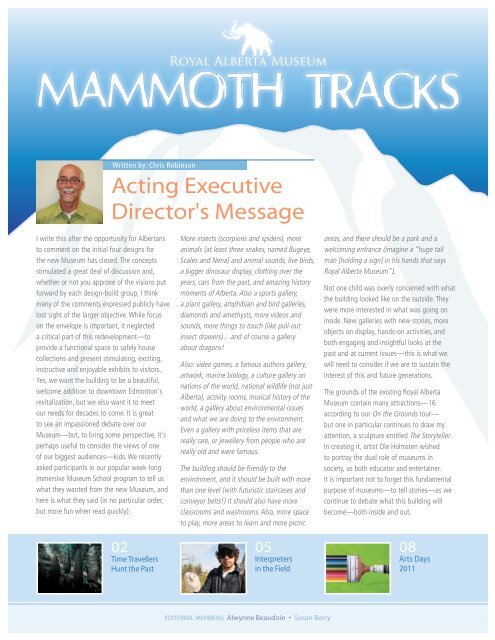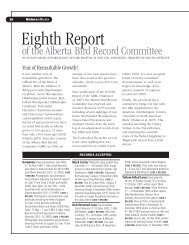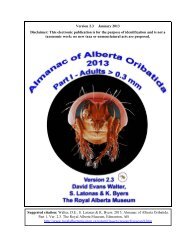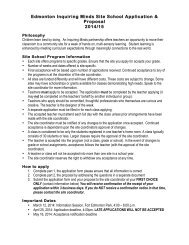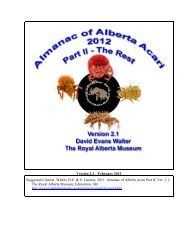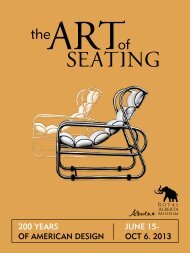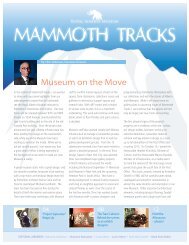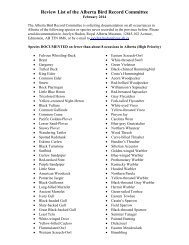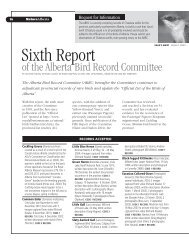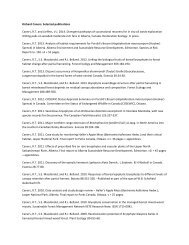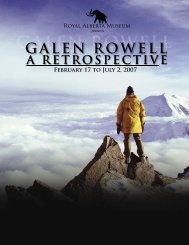MAMMOTH TRACKS - Royal Alberta Museum
MAMMOTH TRACKS - Royal Alberta Museum
MAMMOTH TRACKS - Royal Alberta Museum
Create successful ePaper yourself
Turn your PDF publications into a flip-book with our unique Google optimized e-Paper software.
<strong>MAMMOTH</strong> <strong>TRACKS</strong><br />
Written by: Chris Robinson<br />
Acting Executive<br />
Director's Message<br />
I write this after the opportunity for <strong>Alberta</strong>ns<br />
to comment on the initial four designs for<br />
the new <strong>Museum</strong> has closed. The concepts<br />
stimulated a great deal of discussion and,<br />
whether or not you approve of the visions put<br />
forward by each design-build group, I think<br />
many of the comments expressed publicly have<br />
lost sight of the larger objective. While focus<br />
on the envelope is important, it neglected<br />
a critical part of this redevelopment—to<br />
provide a functional space to safely house<br />
collections and present stimulating, exciting,<br />
instructive and enjoyable exhibits to visitors.<br />
Yes, we want the building to be a beautiful,<br />
welcome addition to downtown Edmonton's<br />
revitalization, but we also want it to meet<br />
our needs for decades to come. It is great<br />
to see an impassioned debate over our<br />
<strong>Museum</strong>—but, to bring some perspective, it's<br />
perhaps useful to consider the views of one<br />
of our biggest audiences—kids. We recently<br />
asked participants in our popular week-long<br />
immersive <strong>Museum</strong> School program to tell us<br />
what they wanted from the new <strong>Museum</strong>, and<br />
here is what they said (in no particular order,<br />
but more fun when read quickly):<br />
02<br />
Time Travellers<br />
Hunt the Past<br />
More insects (scorpions and spiders), more<br />
animals (at least three snakes, named Bugeye,<br />
Scales and Nena) and animal sounds, live birds,<br />
a bigger dinosaur display, clothing over the<br />
years, cars from the past, and amazing history<br />
moments of <strong>Alberta</strong>. Also a sports gallery,<br />
a plant gallery, amphibian and bird galleries,<br />
diamonds and amethysts, more videos and<br />
sounds, more things to touch (like pull-out<br />
insect drawers)…and of course a gallery<br />
about dragons!<br />
Also: video games, a famous authors gallery,<br />
artwork, marine biology, a culture gallery on<br />
nations of the world, national wildlife (not just<br />
<strong>Alberta</strong>), activity rooms, musical history of the<br />
world, a gallery about environmental issues<br />
and what we are doing to the environment.<br />
Even a gallery with priceless items that are<br />
really rare, or jewellery from people who are<br />
really old and were famous.<br />
The building should be friendly to the<br />
environment, and it should be built with more<br />
than one level (with futuristic staircases and<br />
conveyor belts!) It should also have more<br />
classrooms and washrooms. Also, more space<br />
to play, more areas to learn and more picnic<br />
05<br />
Interpreters<br />
in the Field<br />
areas, and there should be a park and a<br />
welcoming entrance (imagine a “huge tall<br />
man [holding a sign] in his hands that says<br />
<strong>Royal</strong> <strong>Alberta</strong> <strong>Museum</strong>”).<br />
Not one child was overly concerned with what<br />
the building looked like on the outside. They<br />
were more interested in what was going on<br />
inside. New galleries with new stories, more<br />
objects on display, hands-on activities, and<br />
both engaging and insightful looks at the<br />
past and at current issues—this is what we<br />
will need to consider if we are to sustain the<br />
interest of this and future generations.<br />
The grounds of the existing <strong>Royal</strong> <strong>Alberta</strong><br />
<strong>Museum</strong> contain many attractions—16<br />
according to our On the Grounds tour—<br />
but one in particular continues to draw my<br />
attention, a sculpture entitled The Storyteller.<br />
In creating it, artist Ole Holmsten wished<br />
to portray the dual role of museums in<br />
society, as both educator and entertainer.<br />
It is important not to forget this fundamental<br />
purpose of museums—to tell stories—as we<br />
continue to debate what this building will<br />
become—both inside and out.<br />
08<br />
Arts Days<br />
2011<br />
EDITORIAL MEMBERS: Alwynne Beaudoin • Susan Berry
<strong>MAMMOTH</strong> <strong>TRACKS</strong><br />
Written by: Alwynne Beaudoin • Curator, Quaternary Environments<br />
The longest-running public program at<br />
the <strong>Museum</strong>, the popular Time Travellers<br />
lecture series returns for its eighteenth<br />
season this fall! Four fascinating lectures<br />
by internationally-renowned scholars will<br />
focus on hunting in the ancient past.<br />
For much of human history, people have relied on hunting<br />
to supply food and materials for clothes, tools, and decoration.<br />
The hunted animals also occupied the very centre of their<br />
spiritual world. The four talks focus on very different animals—<br />
Mammoth, Mastodon, Bison, Pronghorn, Moa, and Harp<br />
Seals—but all show how people through the ages have devised<br />
sophisticated and often complex methods for hunting based<br />
on a deep knowledge of animal biology and behaviour. From<br />
the plains of North America, to the forests of New Zealand<br />
and the cold Atlantic waters off Newfoundland, join us to stalk<br />
and capture a sense of the past in our Time Travellers talks!<br />
Time Travellers<br />
Hunt the Past<br />
Masters of Animals:<br />
Buffalo and Pronghorn Hunting<br />
on the <strong>Alberta</strong> Plains<br />
Jack Brink, <strong>Royal</strong> <strong>Alberta</strong> <strong>Museum</strong><br />
Thursday, September 29, at 7:00 p.m.<br />
Bison (Buffalo) are the largest land mammal in North America, and<br />
Pronghorn (Antelope) are the fastest. Both these wild animals were<br />
killed in large numbers by ancient Aboriginal people of southern<br />
<strong>Alberta</strong>. And both were killed in dramatic fashion by driving herds into<br />
wooden corrals, over cliffs, and into pits dug in the earth. Simple lines<br />
of rocks set purposely in a landscape may appear unimpressive, but<br />
they reveal a compelling story about the mastery of animal behaviour<br />
and biology. Jack Brink will consider new evidence for ancient<br />
Aboriginal Bison and Pronghorn hunting and discuss how these<br />
remarkable kills were conducted.<br />
On the evenings of the lectures the <strong>Museum</strong> will be open<br />
from 5 to 7 p.m., giving visitors a chance to tour our main<br />
floor galleries and visit the Gift Shop.<br />
Single lecture ticket price $8, series price $25<br />
Mammoth Pass holders receive 10% off<br />
To purchase tickets, call 780-453-9100 and press “0”<br />
Tickets may also be purchased at the <strong>Museum</strong>’s Admissions Desk<br />
2 <strong>Royal</strong> <strong>Alberta</strong> <strong>Museum</strong> Mammoth Tracks Newsletter
FALL 2011<br />
Mammoths and<br />
Mastodons as Prey:<br />
Megamammal Hunting<br />
in the Human Past<br />
Dr. Gary Haynes, Anthropology<br />
Department, University of Nevada,<br />
Reno, Nevada<br />
Thursday, October 6, at 7:00 p.m.<br />
Bones of giant elephant-like mammals are<br />
sometimes found directly associated with<br />
human-made stone tools dating back nearly<br />
two million years in Africa, perhaps when<br />
human ancestors merely scavenged carcasses.<br />
Enormous piles of Woolly Mammoth bones<br />
mark human settlements about 25,000<br />
to 15,000 years ago in northern Eurasia,<br />
although people probably didn’t kill all the<br />
animals. Numerous later sites do suggest that<br />
humans killed and butchered now-extinct<br />
elephant-like animals. Surprisingly, North<br />
America has the richest record of Mammothand<br />
Mastodon-killing in the world, with<br />
at least 14 sites dating to around 13,000<br />
years ago. Dr. Gary Haynes describes this<br />
archaeological record and explores clues from<br />
studies of modern elephants that help interpret<br />
sites containing megamammal remains.<br />
No Moa: Whatever<br />
Happened to the Giant<br />
Flightless Birds of New<br />
Zealand<br />
Dr. Brian Kooyman, Department of<br />
Archaeology, University of Calgary,<br />
Calgary, <strong>Alberta</strong><br />
Thursday, October 13, at 7:00 p.m.<br />
New Zealand has been largely isolated from<br />
the rest of the world for some hundred million<br />
years. As a result, it is full of strange and<br />
wonderful animals. You can see many of those<br />
animals even today, but you will not see the<br />
Moa. These flightless birds varied widely in<br />
size, from small turkey-sized species to ones<br />
weighing over 200 kilograms. The Polynesian<br />
ancestors of the Maori people arrived in New<br />
Zealand about AD 1100, yet by the time<br />
the first Europeans arrived in 1769 all the<br />
Moa had disappeared. How did a Polynesian<br />
agricultural people push all the Moa species<br />
to extinction As Dr Kooyman shows, dead<br />
birds do tell tales...<br />
Dorset Palaeoeskimo<br />
Seal Harvesting at Port<br />
au Choix, Northwestern<br />
Newfoundland<br />
Dr. Priscilla Renouf, Department of<br />
Archaeology, Memorial University,<br />
St. John's, Newfoundland<br />
Thursday, October 20, at 7:00 p.m.<br />
Dorset Palaeoeskimos were an Arcticadapted<br />
people who ranged southward<br />
into Newfoundland and the islands of<br />
St. Pierre and Miquelon. Here they found<br />
unprecedented economic opportunity in the<br />
large Harp Seal herds that migrated along<br />
the Newfoundland coast twice yearly. A prime<br />
spot for hunting seals was Port au Choix,<br />
on Newfoundland’s northwest coast. There,<br />
an extraordinary Dorest site called Phillip’s<br />
Garden was occupied by generations of<br />
families for eight centuries (2,000-1,200<br />
years ago). Critical timing, efficient technology,<br />
and coordinated labour comprised the key<br />
to a successful seal hunt. Dr. Priscilla Renouf<br />
describes how the Phillip’s Garden Dorset<br />
hunted seals, processed meat and fat,<br />
and worked the hides.<br />
3
<strong>MAMMOTH</strong> <strong>TRACKS</strong><br />
Written by: Mark Steinhilber, Curator, Ichthyology and Karen Mackie, Head, Visitor Experience<br />
A River Runs Through It<br />
“Rivers are the living force, the roots, the arteries of our planet.<br />
They reflect our history and carry our dreams; they<br />
are our legacy for future generations. We cannot<br />
hesitate to invest in their protection” – Robert Redford<br />
This fall, the <strong>Museum</strong> will host the travelling<br />
exhibition A River Runs Through It. Produced<br />
by the Sherbrooke <strong>Museum</strong> of Nature and<br />
Science in collaboration with the World<br />
Wildlife Fund, the exhibition showcases<br />
human impact on rivers and raises awareness<br />
of the importance of protecting these critical<br />
watercourses. This is very much a familyoriented<br />
production with many interactive<br />
components and activities that lead visitors<br />
on a journey of discovery about river<br />
ecosystems and water management issues.<br />
Interpretive text inspires viewers to think<br />
about the consequences of water diversion,<br />
water consumption, climate change, pollution<br />
and the resulting impacts on species that<br />
inhabit freshwater environments. Activities<br />
that are particularly significant contributors<br />
to our “water footprint”–like energy<br />
generation, industry and agriculture–are<br />
highlighted. But visitors are also challenged<br />
to consider ways that they can reduce water<br />
consumption and are shown examples of<br />
environmentally friendly restoration projects<br />
along some major Canadian rivers.<br />
All of this is presented in a fun, engaging<br />
and immersive context that showcases<br />
many of the plants and animals that interact<br />
in complex river ecosystems. Children can<br />
pretend to fish for salmon in the mighty<br />
Fraser River, transport salmon eggs upriver<br />
to spawning grounds, and climb dams and<br />
fish ladders to learn first-hand the difficulties<br />
that fish face during their life cycle. The<br />
experience will be augmented by a display<br />
showing the diversity of fishes that can be<br />
found in our own North Saskatchewan River.<br />
Interpretive programming will include handson<br />
interaction with real preserved specimens<br />
of the fishes that live in our city.<br />
This bilingual exhibition runs from October<br />
15, 2011, to February 5, 2012. Bring the<br />
entire family to learn more about the natural<br />
treasures that flow through our communities<br />
and enhance our quality of life.<br />
© 1986 Panda symbol WWF-World Wide Fund<br />
For Nature (also known as World Wildlife Fund).<br />
® “WWF” is a WWF Registered Trademark<br />
4 <strong>Royal</strong> <strong>Alberta</strong> <strong>Museum</strong> Mammoth Tracks Newsletter
FALL 2011<br />
Interpreters<br />
in the Field<br />
Written by: Taylor Chadwick<br />
Gallery Interpreter, Wild <strong>Alberta</strong><br />
Mammalogy Curator Dr. Mark Edwards stands amongst burnt trees at the Opal site.<br />
In April, Wild <strong>Alberta</strong> interpreter Kristin Panylyk<br />
and I had the opportunity to spend some time<br />
in the field with Mammalogy Curator Dr. Mark<br />
Edwards, working on a small mammal study.<br />
The fieldwork extended over two weeks and<br />
focused on post-burn sites in the southern<br />
boreal forest north of Edmonton. We were<br />
accompanied by biologist Karyn Swedberg and<br />
Summer Temporary Employment Program (STEP)<br />
student Jordanne Taylor. It was a refreshing<br />
change for Kristin and me to get out into nature<br />
and experience another side of the <strong>Museum</strong>.<br />
“Setting the Line”: Interpreters and field researchers<br />
set up a transect, along which traps will be placed,<br />
at the Bruderheim site.<br />
Visitors are often unfamiliar with many of the<br />
<strong>Museum</strong>’s research projects. Being part of one<br />
directly has allowed Kristin and me to bring out<br />
the messages of the study in our daily work in<br />
the Wild <strong>Alberta</strong> gallery. We have created a new<br />
interpretive program that focuses on the concept<br />
of a mark-and-recapture study to estimate<br />
population numbers and on the specific postburn<br />
site study in which we participated.<br />
Mark’s study looks at the small mammal<br />
community in post-burn sites of varying ages.<br />
We visited sites at Opal (burned May 2010),<br />
Bruderheim (burned 2009) and Redwater<br />
(burned in 2000). We experienced good<br />
weather throughout, with no rain outside a<br />
light sprinkle. That's more than could be said<br />
for the rest of our spring and summer, so we<br />
counted ourselves lucky! These areas were<br />
heavily used by off-road vehicles and in some<br />
cases (Opal and Bruderheim) the fires that ran<br />
through the areas were started by off-road<br />
vehicles such as ATVs.<br />
The animals we encountered were mainly Deer<br />
Mice, but we also tagged a few Voles, Jumping<br />
Mice and one Chipmunk. Small mammals are<br />
usually some of the first critters on the scene<br />
after a forest fire and they take advantage<br />
of widespread seeds and the new vegetation<br />
that invades such sites. Birds of prey flew<br />
Interpreter Taylor Chadwick holds up a Deer Mouse<br />
(Peromyscus maniculatus) after a successful capture<br />
at the Bruderheim site.<br />
overhead and some deer moved through the<br />
area, stopping to feed on small tree seedlings.<br />
It was visual proof that our environment is<br />
both fragile and extremely versatile.<br />
Kristin and I learned a lot about what Mark<br />
does and how to bring the messages of current<br />
scientific research to visitors in a way that is<br />
exciting, dynamic and up-to-date. If you want<br />
to learn more about this study please feel free<br />
to swing by the Wild <strong>Alberta</strong> gallery and look<br />
for Kristin or me. We would be happy to share<br />
this amazing experience with you.<br />
5
<strong>MAMMOTH</strong> <strong>TRACKS</strong><br />
Written by: K. Linda Tzang • Curator, Cultural Communities<br />
H11.35.10003 Canadian Citizenship Certificate, 1958<br />
It is only a small assortment of papers and photographs, but the Yee<br />
collection captures the history of official discrimination against Chinese<br />
Canadians. Central to this collection is Joe Mun ‘George’ Yee’s Head<br />
Tax certificate. A sepia-toned photograph shows us the teenaged<br />
boy whose family paid the Canadian government $500 so that<br />
their son could make his fortune in ‘Gold Mountain’–the Chinese<br />
name for Canada.<br />
The Chinese Head Tax was introduced in 1885 to limit the number of<br />
Chinese immigrants to Canada. While western Canada relied heavily<br />
on Chinese labour, there were fears over the number of ‘Asiatics’<br />
who were settling in the country. Initially costing $50, the Head Tax<br />
was raised to $100 in 1900, then increased to $500 in 1903. Despite<br />
the fact that $500 was equivalent to two years’ wages for a Chinese<br />
labourer, Chinese immigrants continued to come to Canada, fleeing the<br />
civil unrest and drought that were plaguing southern China at the time.<br />
Families cobbled together the $500 so that their sons could make their<br />
fortunes and send money back to their villages.<br />
When the Head Tax failed to deter Chinese immigration, the Canadian<br />
government introduced the Chinese Exclusion Act in 1923. This act<br />
stripped all Chinese Canadians, regardless of their place of birth, of<br />
their citizenship rights and effectively ended Chinese immigration to<br />
Canada. The Act was finally repealed in 1947 when Chinese Canadians,<br />
led by Second World War veterans, convinced Parliament of the<br />
injustice of this law. During the 24 years that the Chinese Immigration<br />
Act was in place, fewer than 50 Chinese people were allowed to<br />
immigrate to Canada.<br />
Other papers in this collection include George Yee’s wife Yuen ‘Lorna’<br />
Lim’s birth certificate from Cumberland, British Columbia, and the Yees’<br />
One Chinese<br />
Canadian Story:<br />
The Yee family<br />
collection<br />
1941 marriage certificate. Under the Chinese Immigration Act, Lorna<br />
lost her status and rights as a Canadian by marrying a non-citizen.<br />
Lorna regained her citizenship following the Act’s repeal. After living<br />
and working as a market farmer in Canada for over 30 years, George<br />
Yee became a Canadian citizen in 1958.<br />
The last document<br />
in the Yee family<br />
collection is a letter<br />
from the Canadian<br />
government<br />
to Lorna Yee<br />
promising to<br />
‘process her ex<br />
gratia payment<br />
as soon as<br />
H11.35.10001 Head Tax Certificate, 1923<br />
possible’. In 2006,<br />
the Canadian government acknowledged the injustice of the Head<br />
Tax and the Chinese Immigration Act. Prime Minister Stephen Harper<br />
issued an official apology in the House of Commons and announced<br />
a symbolic redress payment of $20,000 to surviving payees and their<br />
spouses. Of the estimated 82,000 Chinese who had paid the Head Tax,<br />
only 785—including Lorna Yee—survived to make claims.<br />
But of course, this is just one of the stories that this collection tells.<br />
The collection also offers a sense of the family farm in Black Diamond,<br />
the Yees’ social interactions with friends and neighbours from the<br />
1940s through 2000s, and the growth and expansion of this Chinese<br />
Canadian family as grandchildren and great-grandchildren are<br />
mentioned in documents and appear in photographs.<br />
6 <strong>Royal</strong> <strong>Alberta</strong> <strong>Museum</strong> Mammoth Tracks Newsletter
FALL 2011<br />
Documenting <strong>Alberta</strong>’s<br />
Fish Diversity:<br />
The highs and lows<br />
Preserving, studying and interpreting the<br />
fish diversity of a province as large and<br />
geographically diverse as <strong>Alberta</strong> means<br />
exploring and sampling from the heights of<br />
mountain tops to the depths of our deepest<br />
lakes. This summer, the Ichthyology and<br />
Education programs collaborated on two<br />
new projects. For the Ichthyology program<br />
the objective was to survey the fishes of alpine<br />
lakes and to investigate the use of underwater<br />
video and SCUBA to assess fish populations.<br />
For the Education program the main aim was<br />
to create audio-visual material focused on<br />
scientists at work in the field, suitable for<br />
use in science-based school programs.<br />
The Highs<br />
The Golden Trout (Oncorhynchus aguabonita),<br />
a native of California, has been introduced<br />
into a handful of high altitude lakes in<br />
southern and western <strong>Alberta</strong>. Because of<br />
the limited distribution and the remoteness<br />
of the lakes this species inhabits, it is poorly<br />
represented in our collections. In July and<br />
August, David Parama (Head of Education)<br />
David Parama on Rainy Ridge trail<br />
Written by: Mark Steinhilber • Curator, Ichthyology<br />
and I hiked into three lakes (South Fork,<br />
Barnaby and Rainy Ridge lakes) in the West<br />
Castle River area north of Waterton National<br />
Park in an attempt to acquire a small sample of<br />
voucher specimens of Golden Trout. For two oldtimers,<br />
carrying collecting gear plus hiking and<br />
camping equipment up the side of a mountain<br />
along barely discernible trails proved rather<br />
challenging and elicited a few chuckles from<br />
other hikers and fishermen. But the effort proved<br />
worthwhile as several beautiful specimens<br />
representative of these populations are now<br />
available for display in our new galleries and<br />
for study by interested researchers<br />
The Lows<br />
Rainy Ridge Lake<br />
Golden Trout<br />
Several fish species have recently been placed<br />
on the endangered species list in <strong>Alberta</strong>.<br />
Studying these species may have unwanted<br />
adverse effects on some populations, so<br />
developing new research techniques that have<br />
minimal or no impact on them is important.<br />
For the past two years, we have been<br />
investigating the use of underwater video and<br />
SCUBA to monitor populations of sensitive<br />
species without the need to capture or handle<br />
specimens. Unfortunately, most <strong>Alberta</strong> lakes<br />
Mark Steinhilber underwater with camera<br />
do not have the crystal clear waters that make<br />
photography and videography easy. Cold<br />
Lake, along the <strong>Alberta</strong>/Saskatchewan border,<br />
retains relatively good visibility throughout the<br />
open water season. It has been our primary<br />
study site for experimenting with techniques<br />
to document fish populations using video<br />
and still imagery. Some fish, such as Northern<br />
Pike, Burbot and Sticklebacks, are quite<br />
accommodating and will tolerate the presence<br />
of cameras and divers, but others are more<br />
camera-shy. Members of the Whitefish family<br />
seem particularly wary and are rarely seen.<br />
This includes the endangered Shortjaw Cisco<br />
(Coregonus zenithicus), the species that this<br />
project first studied. Preliminary results suggest<br />
that we will likely find this species only when<br />
large numbers congregate on spawning<br />
grounds and are pre-occupied with their task.<br />
Unfortunately, spawning occurs in November<br />
or December, a time when access onto lakes<br />
and streams is particularly difficult—if the<br />
water isn’t frozen it’s darn cold! Stay tuned<br />
for further updates after we thaw out.<br />
7
<strong>MAMMOTH</strong> <strong>TRACKS</strong><br />
Arts Days 2011<br />
Written by: Janet Waldon • Public Programs Coordinator<br />
<strong>Royal</strong> <strong>Alberta</strong> <strong>Museum</strong><br />
On October 1 and 2, ten of our resident<br />
experts will bring their current projects<br />
into the spotlight and highlight the<br />
artistic side of collections and research.<br />
From trench art to fossils, from ancient<br />
stone artifacts to quilts, from tiny seeds<br />
to kimonos, art is everywhere! Let us<br />
share with you the process, purpose, and<br />
products of creative minds and hands.<br />
Each unique 20-minute presentation<br />
begins on-the-hour; programs run<br />
from 11 a.m. until 3:30 p.m. each day.<br />
Saturday, Oct 1:<br />
11:00 a.m. Sean Moir: Trench Art:<br />
From the tools of war to ‘folk art’<br />
Primarily made from shell casings, bullets<br />
and other munitions, keepsakes known as<br />
trench art were popular during and after the<br />
First World War. Surprisingly few were crafted<br />
by battlefield soldiers.<br />
8 <strong>Royal</strong> <strong>Alberta</strong> <strong>Museum</strong> Mammoth Tracks Newsletter<br />
12:00 p.m. Jack Brink: Disappearing Dreams<br />
at the Zephyr Creek Rock Art Site<br />
New research indicates that painted images<br />
at the Zephyr Creek site were made recently<br />
and are fading quickly. At least some were<br />
created by Nakoda people commemorating<br />
the Sundance ceremony.<br />
1:00 p.m. Chris Jass: Imagining the Past:<br />
The intersection of art and science in<br />
vertebrate palaeontology<br />
Learn how the past is “brought to life”<br />
through palaeontology-based artwork.<br />
2:00 p.m. Bob Dawe: The Artful Bison<br />
Discover rare and beautiful stone carvings<br />
of bison from the North Saskatchewan<br />
River region.<br />
3:00 p.m. Cathy Roy: The 1960s<br />
Wall Hanging<br />
What do woven wall hangings reveal about<br />
<strong>Alberta</strong>’s textile arts traditions<br />
Sunday, Oct. 2<br />
11:00 a.m. Judy Half: InVESTigation:<br />
First Nations beaded vests<br />
The <strong>Museum</strong>’s Aboriginal Liaison Officer–an<br />
accomplished beadworker in her own right–<br />
explores the artistry of beaded vests from<br />
the Northern Plains.<br />
12:00 p.m. Lucie Heins: Art Quilts:<br />
Past and present<br />
From bed quilts to wall quilts, view the artistry<br />
in heritage quilts and contemporary art quilts.<br />
Learn about changes in quilting techniques<br />
and sources of inspiration.<br />
1:00 p.m. Susan Berry: Morning Star<br />
and Many Mules: Historic Kainai art<br />
A collection of Kainai art offers insight into<br />
Blackfoot life at the end of the 19th century.<br />
2:00 p.m. K. Linda Tzang: Art of the<br />
Kimono: Past and future<br />
Join our Cultural Communities curator<br />
in exploring the history of the kimono as<br />
a means to understanding Japanese culture<br />
and identity–past, present and future.<br />
3:00 p.m. Alwynne Beaudoin: Beauty<br />
at Small Scale: Structure and pattern<br />
of seeds under the microscope<br />
Marvel at the intricate patterns and elaborate<br />
structures of common seeds revealed by the<br />
microscope. Even seeds of everyday plants<br />
reveal surprising beauty and complexity<br />
when seen up close.
FALL 2011<br />
Government House<br />
Our good friends at Government House have teamed up with<br />
Alice Major and a variety of local wordsmiths and musicians<br />
to present Swinging Words: Words with Music at Government<br />
House—two afternoons of provocative prose. From the comfort<br />
of the <strong>Alberta</strong> Room, enjoy the talented artistry of these<br />
local performers!<br />
In addition at both sites:<br />
<strong>Museum</strong> Gallery Interpreters and Government House Tour Guides<br />
will be on site throughout the weekend. Drop by and discover a few<br />
of the people, places and things that have shaped our province!<br />
View the full Arts Day 2011 schedule @ www.royalalbertamuseum.ca<br />
The Poetry Route Stops at Chinatown – Saturday, Oct. 1, at 1 p.m.<br />
Edmonton’s original Chinatown is a century old this year. To celebrate,<br />
Edmonton’s bus poetry project, The Poetry Route, will launch a round<br />
of bilingual poems in Chinese and English, from translations of<br />
classic poems to contemporary pieces by local writers. Come for<br />
a sneak preview of the selected poems, accompanied by traditional<br />
Chinese music.<br />
The Edmonton Slam Team Comes out Swinging – Saturday,<br />
Oct. 1, at 3 p.m.<br />
“Spoken word” brings together the rhythmic melodies of storytelling,<br />
the beats of hip-hop, and the politics of rap. The 2011 Edmonton<br />
Poetry Slam Team presents a diverse and dynamic show that will<br />
demonstrate the full range of spoken word poetry, from political<br />
statements backed by beats to personal narratives cloaked in melodic<br />
storytelling. Join us for poetry like you’ve never experienced before.<br />
East Meets West in Lyric – Sunday, Oct. 2, at 1 p.m.<br />
The poet Misuzu Kaneko died in 1930 after a tragically brief life.<br />
Her gentle, haunting poems for children are much loved in Japan<br />
but little known in the West. Come and hear the original poems set<br />
to music along with English translations created by Yukari Meldrum.<br />
Falling Notes, Notes of Fall – Sunday, Oct. 2, at 3 p.m.<br />
Join us for a blending of Celtic music with fall poetry. Words by<br />
Nancy Mackenzie, Kathy Fisher and John Leppard in a swinging<br />
performance with musicians Donna Mae Mohrmann and Nigel Jackman.<br />
9


